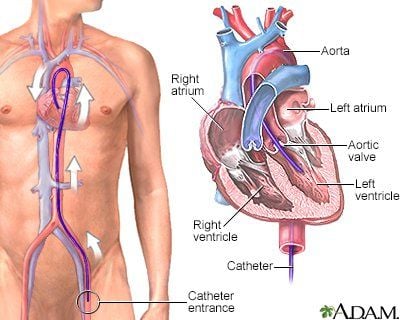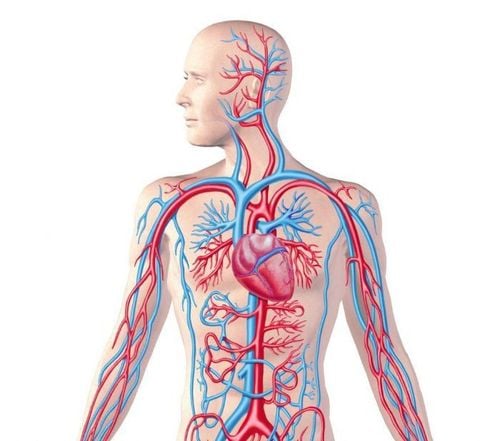This is an automatically translated article.
The article was professionally consulted with Specialist Doctor II Nguyen Quoc Viet - Department of Medical Examination & Internal Medicine - Vinmec Da Nang International General Hospital.A very rare congenital anomaly in which the left coronary artery arises from the pulmonary artery (ALCAPA) instead of from the aortic root. As a malformation with the potential to cause early infant death and sudden adult death, even with compensatory mechanisms in adult patients, there is still an 80-90% rate of sudden death in middle age. average is 35.
1. What is ALCAPA syndrome?
Left coronary artery malformation from the pulmonary artery (ALCAPA) is a congenital heart defect (present in neonates) in which the left coronary artery arises abnormally from the pulmonary artery. Normally, the left and right coronary arteries arise from the aortic root, which supplies blood and oxygen to the heart.ALCAPA was first described in 1866. The first clinical description combined with features on autopsy was described by Bland et al. in 1933, hence the syndrome is also called Bland-White-Garland syndrome.
In children with Alcapa's disease, the left coronary artery arises from the pulmonary artery and carries oxygen-free blood to the left side of the heart. When the heart doesn't get enough oxygen, the heart muscle can weaken or die, similar to having a heart attack. Damaged heart muscle cannot pump blood efficiently, leading to cardiomyopathy and heart failure.
ALCAPA syndrome is a very rare condition that can cause dangerously poor heart function in infants. Surgery is needed to correct the defect. Without intervention, most babies don't make it past the first year, but with timely surgery, most babies are healthy and live normal lives.
2. Causes of ALCAPA . syndrome
ALCAPA is an abnormality that occurs when a baby's heart is developing early in pregnancy. In a normal heart, the left coronary artery originates from the aorta. It supplies oxygen-rich blood to the heart muscle on the left side of the heart as well as the mitral valve (the heart valve located between the upper and lower chambers of the heart on the left side).In children with ALCAPA syndrome, the left coronary artery (LCA) originates in the pulmonary artery. The pulmonary artery is the main blood vessel that carries oxygen-poor blood from the heart to the lungs for oxygen.
When this defect occurs, oxygen-depleted blood is delivered to the heart muscle on the left side of the heart. Therefore, if the heart muscle does not receive enough oxygen, the tissues begin to die due to lack of oxygen. This can cause a heart attack in the baby.
A condition known as "coronary theft" further damages the heart in infants with alcapa. Low blood pressure in the pulmonary artery causes blood from the LCA to be abnormally connected, backing the pulmonary artery instead of the heart muscle. This results in less blood and oxygen reaching the heart muscle. This problem can also lead to a heart attack in the baby. The phenomenon of “coronary theft” develops over time in infants with ALCAPA if the condition is not treated early.

3. Signs and symptoms of ALCAPA
3.1. Clinical Symptoms In infants, ALCAPA symptoms may include:Blue or purple discoloration of gums, tongue, skin and fingernails (cyanosis). Poor eating and weight gain. Rapid or rapid breathing. Sweat a lot, especially when feeding. Drowsiness more than usual. Unresponsive (baby seems "disliked"). Heart murmur - an abnormal heart sound when the doctor listens with a stethoscope. 3.2. Paraclinical symptoms Testing and diagnosis of anomalous left coronary artery from pulmonary artery. ALCAPA syndrome is undetectable during pregnancy. In most cases, ALCAPA is diagnosed in the first one to two months of life, after a parent or pediatrician notices symptoms. In rare cases, children don't have noticeable ALCAPA symptoms until they are toddlers or older.
3.3. Imaging Chest X-ray: usually shows a larger-than-normal heart. Echocardiography: can confirm the diagnosis. However, because coronary artery imaging is sometimes difficult, cardiac catheterization and cardiac MRI are used to help with the diagnosis. Electrocardiogram (ECG): may show evidence of myocardial ischemia. Cardiac MRI: A three-dimensional image that shows abnormalities of the heart. In many cases, cardiac catheterization will also be required. In cardiac catheterization, a thin tube is inserted into the heart through a vein or artery in the leg or navel.
4. Treatment of ALCAPA . syndrome
Surgery is required to correct ALCAPA. include:Separation of the left coronary artery from the pulmonary artery and suturing in the correct position on the aorta. Create a tunnel from the aorta to the anomalous left coronary artery, then close the junction between the left coronary artery and the pulmonary artery. Remove the ruptured left coronary artery, using the vein from the leg to create a new left coronary artery. Make a connection between the left subclavian artery (the large artery that carries blood to the left arm and upper body) and the left coronary artery. This allows some very oxygen-rich blood from the subclavian artery to feed the left coronary artery and heart. In summary, ALCAPA syndrome is a rare but potentially fatal congenital coronary anomaly in neonates and sudden death in adults. Therefore, screening for early detection and treatment of the disease is very important.
Currently, Cardiovascular Center - Vinmec International General Hospital is one of the leading centers in the country for examination, diagnosis, screening and treatment of cardiovascular diseases. Vinmec not only has the convergence of a team of experienced and reputable leading experts in the field of surgical treatment, internal medicine, interventional cardiac catheterization, but also has a system of modern equipment, on par with The most prestigious hospitals in the world such as: MRI 3 Tesla (Siemens), CT 640 (Toshiba), high-end endoscopy equipment EVIS EXERA III (Olympus Japan), high anesthesia system Avace level, Hybrid operating room according to international standards... Especially, with the space designed according to 5-star hotel standards, Vinmec ensures to bring patients the most comfort, friendliness and peace of mind. .
Please dial HOTLINE for more information or register for an appointment HERE. Download MyVinmec app to make appointments faster and to manage your bookings easily.














